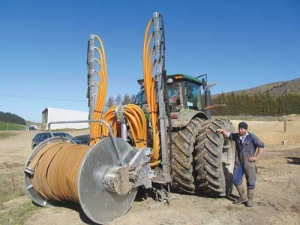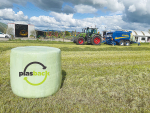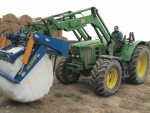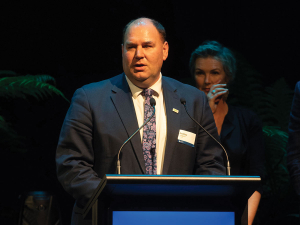A SlurryQuip umbilical effluent system on a South Canterbury farm has the thumbs-up from the owner, says the supplier, Webbline.
Ikawai Dairies, in south Waimate, last month bought a Slurryquip system and within the first two weeks was reaping the benefits.
Farm spokesman Ben Smith said before the umbilical system they discharged effluent out through the pivots, but blockages took a lot of time to fix and this detracted from grass growth.
Webbline sales manager Glen Malcolm says compared to other methods of effluent discharge the Slurryquip system can move large amounts of slurry quickly.
“Take a 20,000L tanker for example: if you are averaging three loads an hour, this equates to only 60,000L/hour discharge, versus the Slurryquip’s discharge rates of at least 200,000L/hour.”
Ikawai Dairies tractor driver Perry Henriksen echoed the comments: “I’m amazed at the volume we move with this unit. It’s taken me a few days to get the hang of the process; with his block being very hilly, I am learning to use it mainly on the hills which is more difficult than operating on the flat.
“We have five ponds between the farms, collecting effluent from 4000 cows…. The Slurryquip is set up with nearly 2km of hose with a mixture of 150mm and 125mm, then discharged out through a 9m dribble bar.
“This week we have been discharging on quite steep hills, and I have been pumping about 1.5km with a lift from the pump to outlet of up to 100m and even then still achieving nearly 200,000L/hour discharge. Compared to applying on the flat we are getting more like 230,000-250,000L/hour. This is impressive when we are running the pump on a 150hp John Deere 6920.”
And it can pump thick material, Henriksen says.
“One of the ponds had a crust thick enough to walk on and we put the NC stirrer into the pond and were able to stir up everything and pump it out.”
Malcolm says the Slurryquip system can be extended at any time. “For example we can set up a basic unit with about 800m of hose for no more than $100,000, so a dairy farmer or contractor can lease a basic system for a little over $20,000 per season. Then as time or funds permit you can add to it, i.e. more hose, GPS systems for proof of placement, etc.
“With the Slurryquip interchangeable reel system, if the operator needs more hose he need only buy another reel to carry it on as the reel lifters are interchangeable. He can be running several reels of hose and have only one lifter, saving money.”
Malcolm says pumping distance is no problem. “We had a client earlier in the winter who had set up two pumps, one at the pond and one pump inline, and was pumping 3.5km from the shed to the runoff block and still achieving a discharge of more than 100,000L/hour.”
Tel. 0800 932 254
www.webbline.co.nz


















